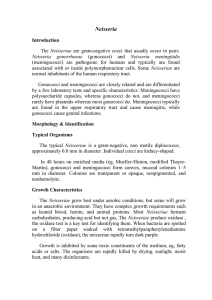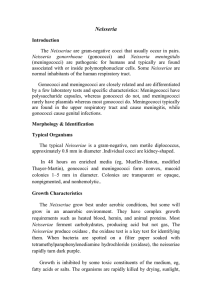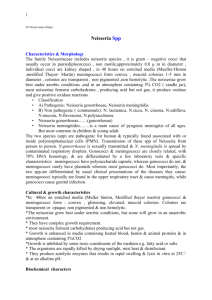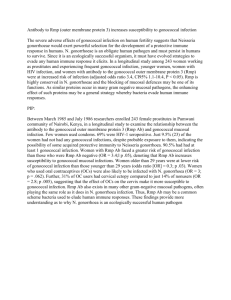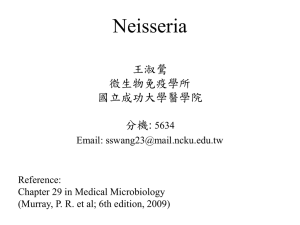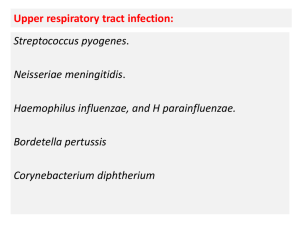Document 12481516
advertisement
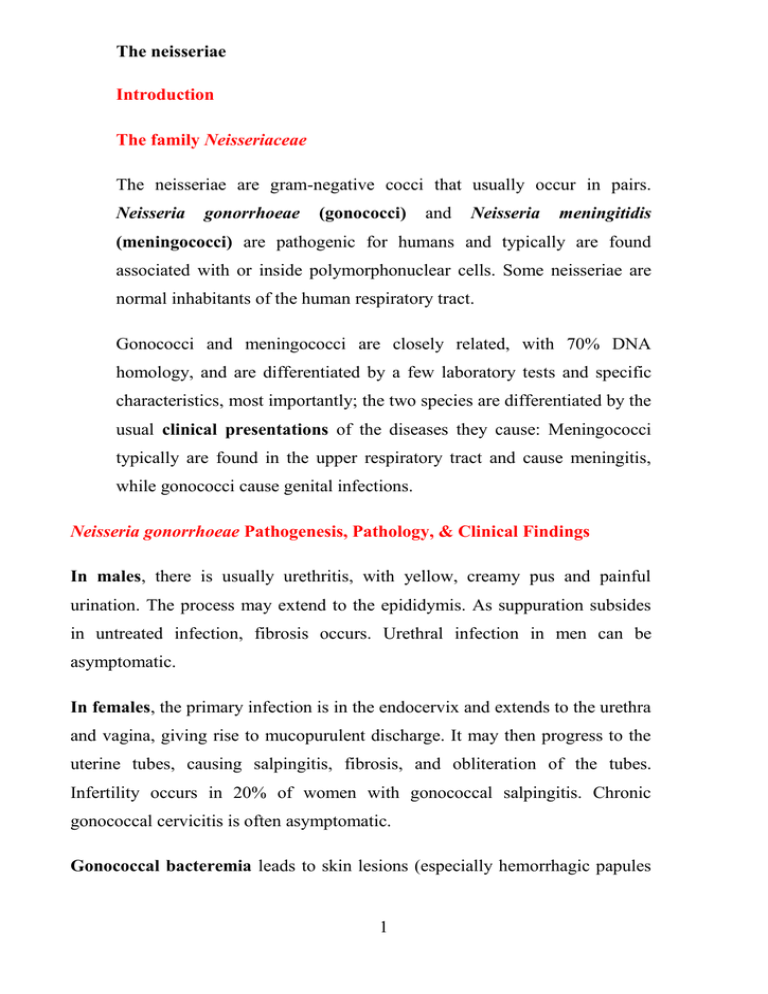
The neisseriae Introduction The family Neisseriaceae The neisseriae are gram-negative cocci that usually occur in pairs. Neisseria gonorrhoeae (gonococci) and Neisseria meningitidis (meningococci) are pathogenic for humans and typically are found associated with or inside polymorphonuclear cells. Some neisseriae are normal inhabitants of the human respiratory tract. Gonococci and meningococci are closely related, with 70% DNA homology, and are differentiated by a few laboratory tests and specific characteristics, most importantly; the two species are differentiated by the usual clinical presentations of the diseases they cause: Meningococci typically are found in the upper respiratory tract and cause meningitis, while gonococci cause genital infections. Neisseria gonorrhoeae Pathogenesis, Pathology, & Clinical Findings In males, there is usually urethritis, with yellow, creamy pus and painful urination. The process may extend to the epididymis. As suppuration subsides in untreated infection, fibrosis occurs. Urethral infection in men can be asymptomatic. In females, the primary infection is in the endocervix and extends to the urethra and vagina, giving rise to mucopurulent discharge. It may then progress to the uterine tubes, causing salpingitis, fibrosis, and obliteration of the tubes. Infertility occurs in 20% of women with gonococcal salpingitis. Chronic gonococcal cervicitis is often asymptomatic. Gonococcal bacteremia leads to skin lesions (especially hemorrhagic papules 1 The neisseriae and pustules) on the hands, forearms, feet, and legs and to tenosynovitis and suppurative arthritis, usually of the knees, ankles, and wrists. Gonococcal endocarditis is an uncommon but severe infection. Gonococcal ophthalmia neonatorum, an infection of the eye of the newborn, is acquired during passage through an infected birth canal, if untreated, results in blindness. Diagnostic Laboratory Tests Specimens: Pus and secretions are taken from the urethra, cervix, rectum, conjunctiva, throat, or synovial fluid for culture and smear. Blood culture is necessary in systemic illness. Smears: Gram-stained smears of urethral or endocervical exudate reveal many diplococci within pus cells. Culture: Immediately after collection, pus or mucus is streaked on enriched selective medium (eg, modified Thayer-Martin medium) and incubated in an atmosphere containing 5% CO2 (candle extinction jar) at 37 °C. To avoid overgrowth by contaminants, the selective medium contains antimicrobial drugs (eg, vancomycin, and trimethoprim). If immediate incubation is not possible, the specimen should be placed in a CO2-containing transport-culture system. Forty-eight hours after culture, the organisms can be quickly identified by their appearance on a Gram-stained smear, by oxidase positivity, or other laboratory tests. Serology: In infected individuals, antibodies to gonococcal pili and outer membrane proteins can be detected by immunoblotting, radioimmunoassay, and ELISA (enzyme-linked immunosorbent assay) tests. 2 The neisseriae Immunity: Repeated gonococcal infections are common. Protective immunity to reinfection does not appear to develop as part of the disease process, because of the antigenic variety of gonococci. Treatment Many strains require high concentrations of penicillin G. Uncomplicated genital or rectal infections be treated with ceftriaxone given intramuscularly as a single dose. Additional therapy with doxycycline, orally twice a day for 7 days, is recommended for the possible concomitant chlamydial infection; erythromycin base, orally four times a day for 7 days, is substituted for doxycycline in pregnant women. combination therapy using two antimicrobials with different mechanisms of action (e.g., a cephalosporin plus azithromycin) to improve treatment efficacy and potentially slow the emergence and spread of resistance to cephalosporins Since other sexually transmitted diseases may have been acquired at the same time as gonorrhea, steps must also be taken to diagnose and treat these diseases (chlamydiae, syphilis, etc). Epidemiology, Prevention, & Control Gonorrhea is worldwide in distribution. Gonorrhea is exclusively transmitted by sexual contact, often by women and men with asymptomatic infections. The infectivity of the organism is such that the chance of acquiring infection from a single exposure to an infected sexual partner is 20–30% for men and even greater for women. The infection rate can be reduced by avoiding multiple sexual partners, rapidly eradicating gonococci from infected individuals by means of early diagnosis and treatment, and finding cases and contacts through education and screening of populations at high risk. Chemoprophylaxis is of 3 The neisseriae limited value because of the rise in antibiotic resistance of the gonococcus. Gonococcal ophthalmia neonatorum is prevented by local application of 0.5% erythromycin ophthalmic ointment or 1% tetracycline ointment to the conjunctiva of newborns. Neisseria meningitidis Pathogenesis, Pathology, & Clinical Findings Humans are the only natural hosts for whom meningococci are pathogenic. The nasopharynx is the portal of entry. There, the organisms attach to epithelial cells with the aid of pili; they may form part of the transient flora without producing symptoms. From the nasopharynx, organisms may reach the bloodstream, producing bacteremia; the symptoms may be like those of an upper respiratory tract infection. Fulminant meningococcemia is more severe, with high fever and hemorrhagic rash; there may be disseminated intravascular coagulation and circulatory collapse (Waterhouse-Friderichsen syndrome). Meningitis is the most common complication of meningococcemia. It usually begins suddenly, with intense headache, vomiting, and stiff neck, and progresses to coma within a few hours. There may be interstitial myocarditis, arthritis, and skin lesions. In meningitis, the meninges are acutely inflamed, with thrombosis of blood vessels and exudation of polymorphonuclear leukocytes, so that the surface of the brain is covered with a thick purulent exudate. Diagnostic Laboratory Tests Specimens: Specimens of blood, spinal fluid Nasopharyngeal swab are taken for smear, culture, and chemical determinations. 4 The neisseriae Smears: Gram-stained smears of the spinal fluid. Culture: A modified Thayer-Martin medium with antibiotics (vancomycin, colistin, amphotericin) favors the growth of neisseriae, inhibits many other bacteria, and is used for nasopharyngeal cultures. Serology: can be measured by latex agglutination or hemagglutination tests. Immunity: A newly approved (2005) tetravalent conjugate vaccine is licensed for use in persons 11–55 years of age. It contains capsular polysaccharide conjugated to diphtheria toxoid. Treatment Penicillin G is the drug of choice for treating meningococcal disease. Either chloramphenicol or a third-generation cephalosporin such as cefotaxime or ceftriaxone is used in persons allergic to penicillins. Other Neisseriae Moraxella catarrhalis It is a member of the normal flora in 40–50% of normal school children. M catarrhalis causes bronchitis, pneumonia, sinusitis, otitis media, and conjunctivitis. It is also of concern as a cause of infection in immunocompromised patients. Most strains of M catarrhalis can be differentiated from the neisseriae by its lack of carbohydrate fermentation and by its production of DNase. It produces butyrate esterase, which forms the basis for rapid fluorometric tests for identification. 5
